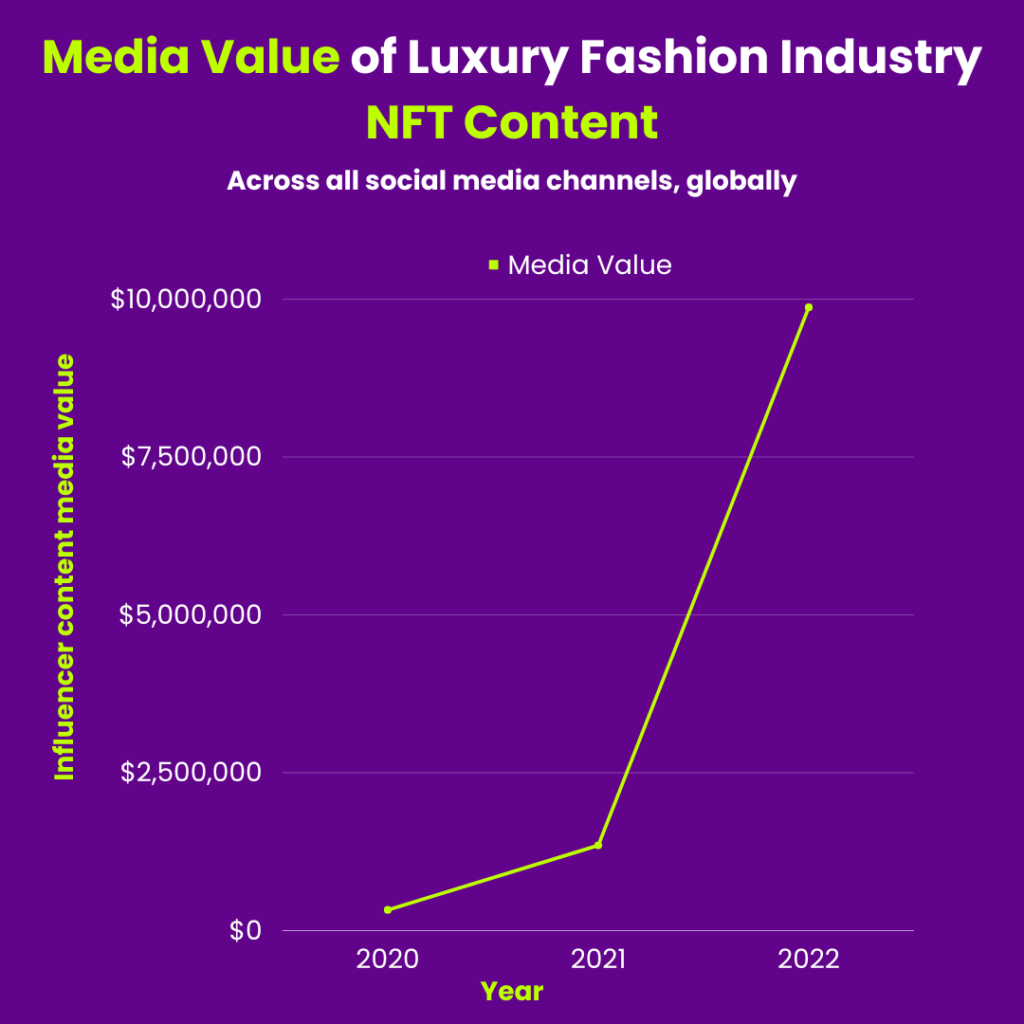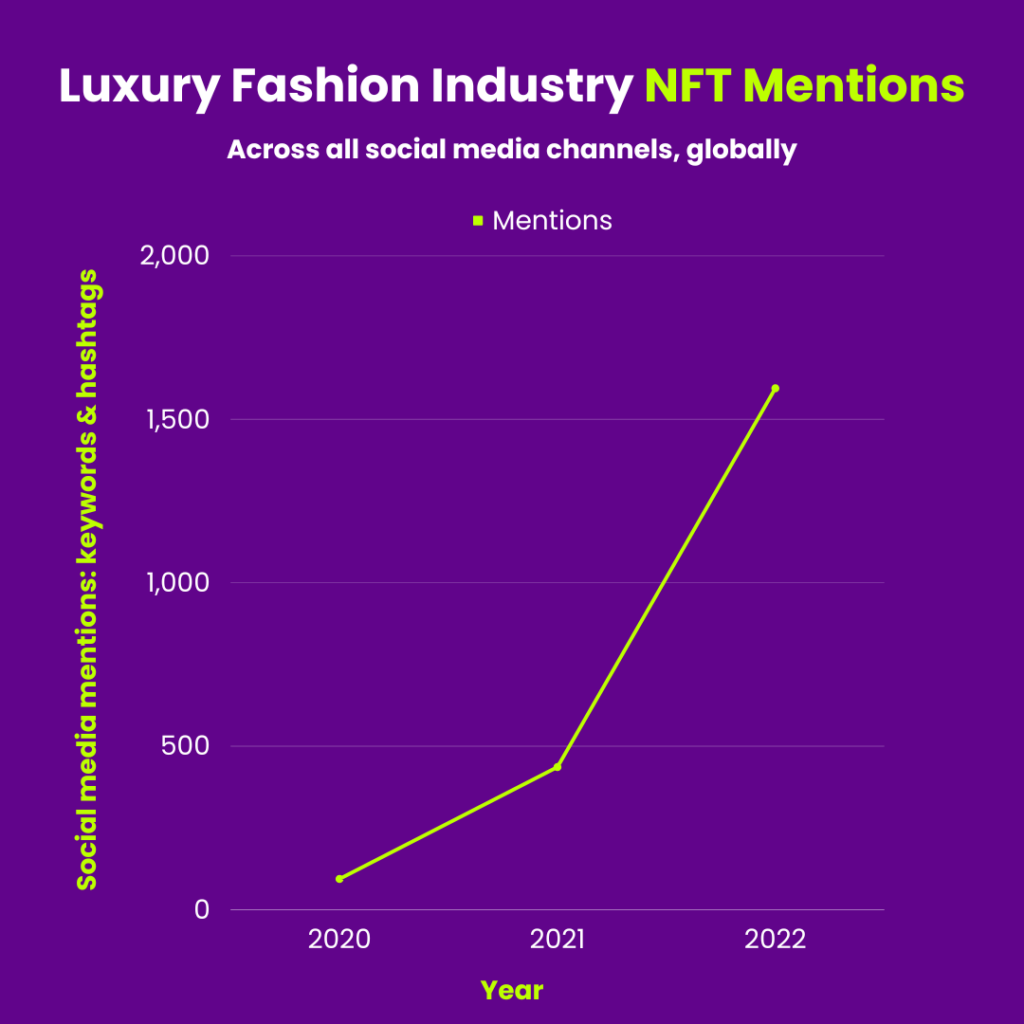Web3 is reshaping luxury marketing with blockchain technology and Web3 influencers. WeArisma’s data shows a significant rise in NFT mentions and media value from 2020 to 2022. Gucci and Tiffany & Co. are at the forefront, using Web3 collaborations and NFTs to drive engagement and sales. Virtual influencers like Prada’s Candy and Tommy Hilfiger’s Daisy are also enhancing brands’ digital presence. As Web3 evolves, luxury brands are uniquely engaging consumers through these innovations.

Published On: April 13, 2023
In recent years, Web3 has revolutionised how brands approach influencer marketing in the luxury sector. By uniting blockchain technology, and working with Web3 and meta influencers, luxury brands now have the potential to explore new avenues of marketing and engage with consumers in a way that wasn’t previously possible.
WeArisma analytics reveals a significant increase in NFT mentions and media value within the luxury industry across influencers in 2022 compared to 2020. This trend indicates a growing interest in blockchain and Web3 from both brands and influencers. For this reason, some of the most prestigious luxury brands have already found unique ways of tapping into this new market and extending their product portfolios.


Gucci is one of the luxury houses that has expanded into the Web3 space by inviting Web3 influencers to their shows. Twitch streamer and gamer, Pokimane attended their Milan Fashion Week 2023 show, sharing her experience with her Instagram followers with her posts generating an impressive media value of $657K and an engagement rate of 6.4%. This shows that by expanding into a new market Gucci was not only able to drive brand engagement but also to position themselves as a leader within the luxury Web3 space. Alongside this Gucci has launched their own NFT collection in collaboration with Superplastic.
Tiffany & Co. are also leveraging NFTs in their influencer marketing strategy by giving owners of a CryptoPunk NFT access to the sales of “NFTiffs”, custom necklaces that sold out in half an hour. By leveraging NFT’s Tiffany was able to create a sense of exclusivity and excitement around their products, with many personalised necklace owners sharing their purchases on Twitter, as well as driving brand engagement and sales.
Luxury brands are also working with or creating their own virtual influencers on Web3. Prada relaunched their own virtual ambassador, Candy, for the release of their Spring/Summer collection in 2021. Whilst, Tommy Hilfiger invited Yoox’s CGI influencer, Daisy, to their event for the release of their new collection in April 2023. The use of virtual influencers is beneficial for luxury brands as they are able to shape a digital presence that reflects their core values, essence, and target demographic, whilst maintaining a human-like behavior and appearance.
The emergence of Web3 has disrupted traditional influencer marketing strategies within the luxury sector, presenting an opportunity for brands to engage with audiences in innovative ways. This trend is expected to grow as more luxury brands explore the potential of Web3. As the digital landscape advances, it is important for brands to stay ahead of the curve in order to keep up with their competitors.
Keep informed with the latest trends, reports, and case studies from the world of influencer marketing.
In beauty, things move fast. But strategy? That’s what sets the leaders apart.
Our 2025 Beauty State of Influence Report is packed with insights, but knowing how to turn those into action is where the real value lies. Whether you’re optimising influencer partnerships, reallocating budgets, or jumping on the right trends, here’s how to make the most of your data.
WeArisma’s Personal Care 2025 State of Influence Interactive Report – The Definitive Guide to Winning in Bath and Body, Hair Care, Skincare, and Wellness Through Influencer Strategy
The personal care market is booming – but only the most emotionally resonant brands are cutting through the noise. Authenticity, expert credibility, and self-care storytelling are driving the next wave of influence.
Our Personal Care 2025 State of Influence Report reveals how Dove, Nivea, Aquaphor, and Bevel are shaping the future of the category – and how your brand can do the same.
Stay up to date with the latest industry trends and topics
Discover how WeArisma can help you harness the power in influence, grow your brand’s presence, and achieve measurable success.
WeArisma combines the power of AI, influencer marketing and social listening to deliver smarter, scalable strategies with real impact.